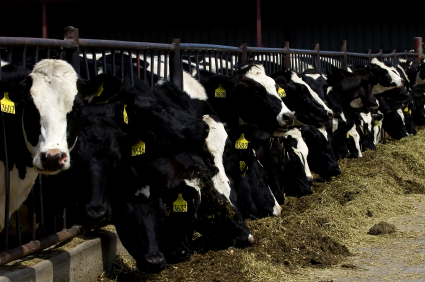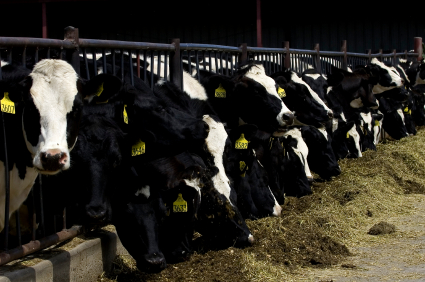 Much as I’ve long been taken with the romanticism of dairy farming and the visions of grazing cows and nurturing fresh milk it conjures up, I tune out when the talk turns to “the dairy industry.”
Much as I’ve long been taken with the romanticism of dairy farming and the visions of grazing cows and nurturing fresh milk it conjures up, I tune out when the talk turns to “the dairy industry.”
That subject stimulates images of commodity trading, price controls, feed lots, and perhaps most onerous– a rigged system akin to slavery in which the owners of small dairies nearly always lose. They have been losing for so many years the number of farms with dairy cows fell an astounding 88 percent, from 648,000 to 75,000 between 1960 and 2006, the U.S. Department of Agriculture reports.
Those who control the dairy industry — the Dean Foods and other huge processors, along with so-called “dairy cooperatives”–don’t see a problem in all this since they continue to make big profits as “the industry” consolidates. They definitely don’t want to hear about opportunities for entrepreneurship and economic growth for dairy farms, such as in the emerging opportunity coming via growing demand for raw milk. Demand so strong it’s enabled California dairy Organic Pastures Dairy Co. to grow from an apple grower into the largest raw dairy in the country over the last seven years, with a reported 60,000 customers and fat profits reaped from fetching up to $17 a gallon for milk. Dozens of other smaller raw dairies in Pennsylvania, Ohio, and Michigan are thriving from similar growing demand, and a marketplace that rewards them with between $7 and $10 a gallon, versus about $1 a gallon for milk sold to Dean Foods and the dairy cooperatives.
So when the U.S. Department of Agriculture secretary Tom Vilsack announced a few days ago the appointment of 17 members of a new Dairy Industry Advisory Committee to tell him how to deal with the dairy crisis, at first I tuned out. It sounded to me like more of the same — government officials talking sympathetically to the poor dairy farmers standing around hat-in-hand, while behind the scenes the same government officials continue tilting the system to benefit Dean Foods and other processors. Pathetic stuff, something like rearranging the deck chairs on the Titanic.
Then I was listening to a New Hampshire Public Radio program Monday morning about, none other than “the dairy dilemma” and what to do about it. One of the guests on the call-in panel discussion was Deborah Erb, a New Hampshire dairy farmer appointed to serve on the committee for the next two years. She was on the program together with an official of a dairy cooperative, and the head of a Republican think tank.
I decided to call in and see what Deborah might have to say about my idea to put state agriculture departments to work educating interested owners of smaller dairies on the fine art of producing safe and nutritious raw milk, as a way to fulfill their mandates to promote agriculture. Ag departments in a number of states like New York and Wisconsin spend much of their time harassing small dairies that seek to escape economic servitude by selling raw milk, rather than cooperating with them to help them succeed.
As I waited about 45 minutes for my turn to speak, I listened to the discussion about the dairy industry’s dilemma, and tried hard not to tune out. It was just so pathetic.
They talked about how more than 100 New England Dairy farms went out of business last year, which is possibly as many as 10 percent of the region’s 1,600 to 1,800 remaining dairies. Someone mentioned that perhaps 30 percent of every consumer dollar spent on dairy products goes to the farmer, versus 50 percent in the 1960s, and nearly 100 percent at the turn of last century.
The panelists also talked about how the federal government appropriated more than $300 million last year to artificially raise dairy prices paid to farmers, and how that amounted to three-and-a-half cents a gallon of milk, or maybe $6,000-$7,000 per dairy. “If you lost $60,000 or $70,000 last year, it helped,” one of the guests said hopefully. All I could think is that the dairy farmers need to find a Goldman Sachs big shot to get at some of those billions the government sent to the nation’s biggest banks last year.
But my ears perked up when Deborah Erb was asked about the new USDA dairy advisory committee. “I hope to think outside the box,” she stated. Now there’s the seeds of change we can believe in.
Finally, my turn as a caller came. I identified myself as the author of the new book, The Raw Milk Revolution, and briefly described my idea of encouraging small dairies to exploit the fast-growing raw milk market. Then I asked Deborah whether she would bring this idea up to the new committee.
I was surprised at how knowledgeable she was about the subject. “Today’s milk supply is a lot cleaner than it once was,” she volunteered. One potential problem with raw milk, she said, was that it doesn’t travel real well. “As people get further from the farm, (raw milk) becomes problematic … ” Ah, but then she returned to her “box.” “I certainly am open to thinking outside the box.”
Did that represent a commitment to give raw milk a hearing before the new committee? Unfortunately, I was cut off before I had a chance to follow up.
But even “thinking outside the box” — forget about real action — would be progress among the dairy industry crowd that will be advising the USDA secretary. Slight progress, perhaps, since we’re not talking about an end to the servitude that marks the smaller dairy farmer’s current economic role. No, slaves need to fight for their freedom, and it’s not clear that a new USDA advisory committee is prepared to take on that role.



